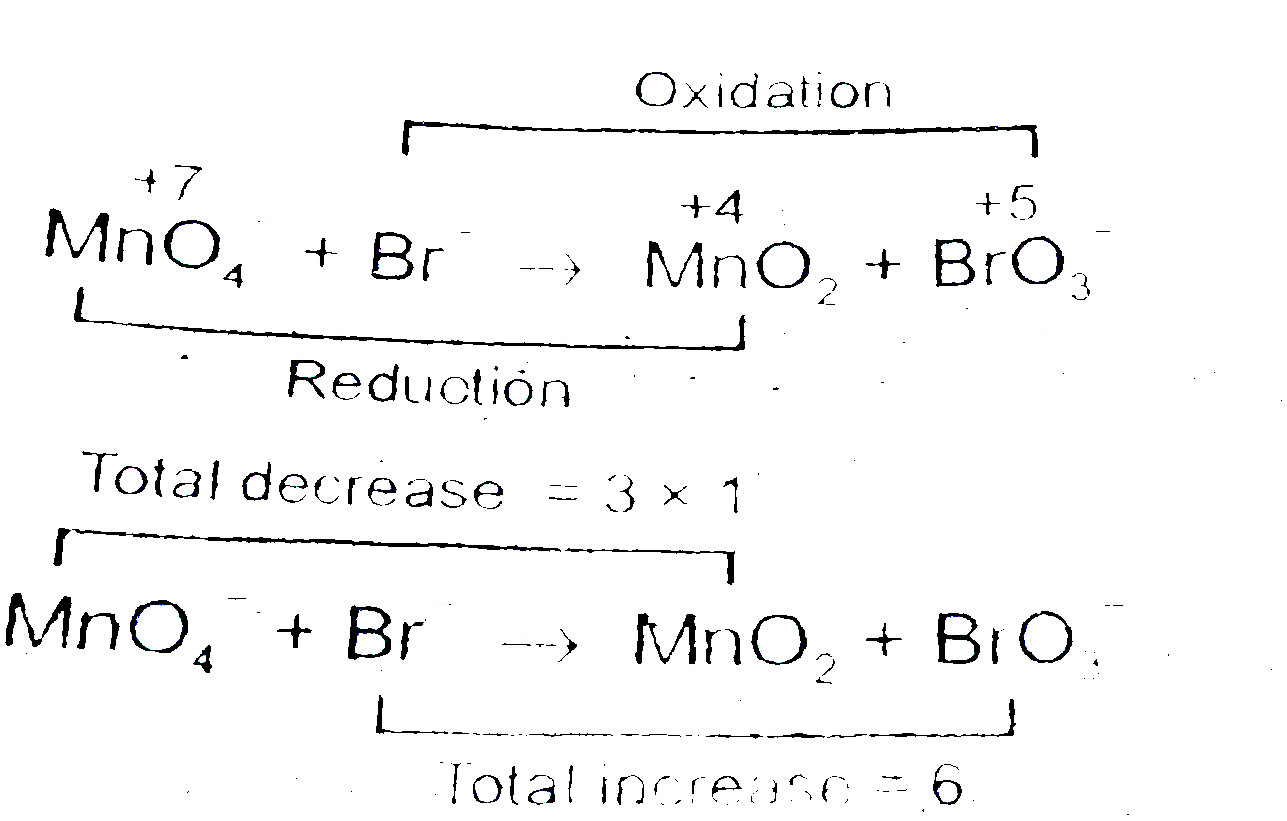MnO−4(aq)+Br−(aq)→MnO2(aq)+BrO−3(aq)
Video Solution
Text Solution

equation increase and decrease in oxidation number
2MnO−4(aq)+Br−(aq)→2MnO2(s)+BrO−3(aq)
Reaction is in basic medium, and the ionic charges are not equal on both sids, add 2 OH− ions on the right to make ionic charges equal.
2MnO−4(aq)+Br−(aq)→2MnO2(s)+BrO−3(aq)+2OH−(aq)
Add one H2O to L.H.S. to achieved balanced redox change
2MnO−4(aq)+Br−(aq)+H2O(I)→2MnO2(s)+BrO−3(aq)+2OH−(aq)
|
Topper's Solved these Questions
- REDOX REACTIONSBook:AAKASH INSTITUTEChapter:REDOX REACTIONSExercise:Try Yourself
Explore 28 Videos
- REDOX REACTIONSBook:AAKASH INSTITUTEChapter:REDOX REACTIONSExercise:Assignment (Section A) (Objective type Questions (one option is correct))
Explore 40 Videos
- PRINCIPLES OF QUALITATIVE ANALYSISBook:AAKASH INSTITUTEChapter:PRINCIPLES OF QUALITATIVE ANALYSISExercise:Assignment (SECTION H)
Explore 9 Videos
- SOLUTIONSBook:AAKASH INSTITUTEChapter:SOLUTIONSExercise:ASSIGMENT (SECTION-J) AAKASH CHALLENGERS QUESTIONS
Explore 10 Videos
Similar Questions
Knowledge Check
CH3CH2BrAq.KOH−−−−−→ΔAKMnO4/H+−−−−−−−−→ΔBNH3−−→ΔCBr2−−→AlkaliD, D is
ACH3BrBCH3CONH2CCH3NH2DCHBr3I−(aq.)+MnO−4(aq.)H+−−→X+Mn2+(aq.)
I−(aq.)+MnO−4(aq.)Neutral or−−−−−−−−→weakly OH−Y+MnO2
MnO−4(aq.)+Mn2+(aq.)ZnSO4−−−→Z+4H+
Product X, Y and Z are respectively.AI2,IO−3,MnO2BIO−3,I2,MnO2CI2,IO−3,MnO2−4DIO−3,I2,MnO2−4(i) BaCO3+Na2aq.suspensionCrO4+AcOH→Mppt.
(ii) BaCO3+Na2aq.suspensionCrO4+HCN→Nppt.
Which is the correct option regarding the above reactions?AM and N are the same and characterized as BaCrO4.BM is BaCrO4 and N stands for no precipitate.CM is BaCrO4 and N is BaCO3.DM stands for no precipitate and N is BaCrO4.
CuCl2(aq)CopperChloride+2KI(aq)Potassiumiodide→CuI2Copperiodide⏐⏐ ⏐ ⏐ ⏐↓+2KCl(aq)Potassiumchloride
View SolutionCuSO4(aq)CopperSulphate+Fe(s)→FeSO4(aq)FerrousSulphate+Cu(S)
View SolutionZn(s)∣∣Zn2+(aq)∣∣∣Cu2+(aq)∣Cu(s)(cathode)(anode) is
View SolutionThe reaction shows which of the following mechanisms?
CH3−C∣CH3H−ClKOH(aq)−−−−−→CH3−CH∣CH3−OH+Cl−
View SolutionThe following reaction is at equilibrium ,
Fe3+(aq)Yellow+SCN(aq)Colourless⇒[Fe(SNC)]2+(aq)Deep red
Kc=[Fe(SCN)][Fe3+][SCN]
In the above reaction , colour intensity of red colour can be increased by :-
View Solution

